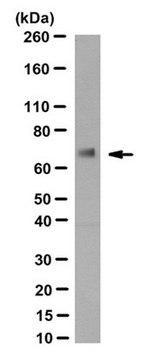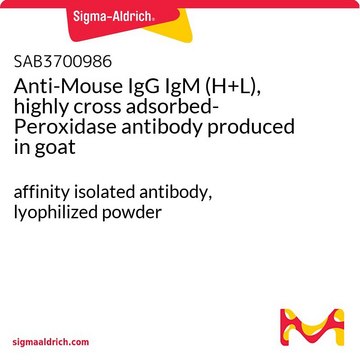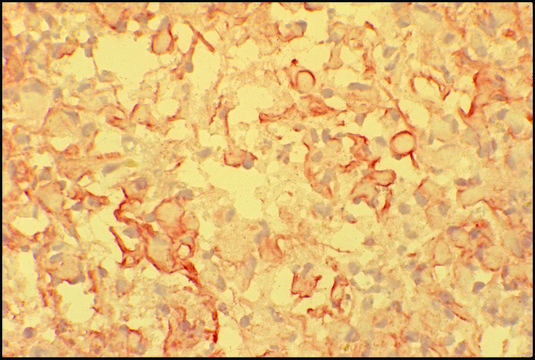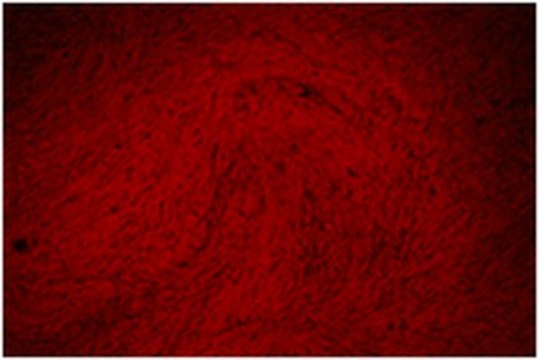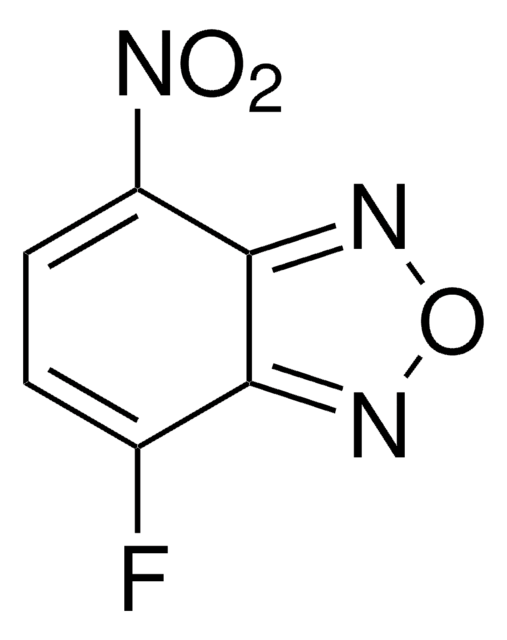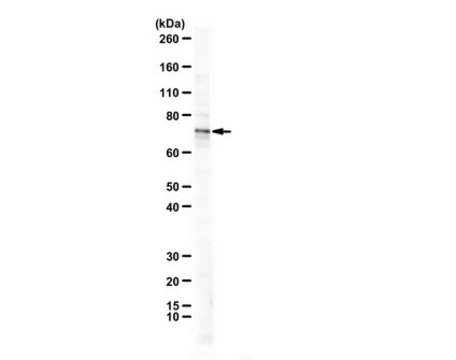推荐产品
生物来源
mouse
质量水平
抗体形式
purified antibody
抗体产品类型
primary antibodies
克隆
HRV-18003, monoclonal
分子量
calculated mol wt 242.824 kDa
observed mol wt ~32 kDa
纯化方式
using protein G
种属反应性
virus
包装
antibody small pack of 100
技术
ELISA: suitable
inhibition assay: suitable
western blot: suitable
同位素/亚型
IgG2aκ
表位序列
N-terminal half
Protein ID登记号
UniProt登记号
储存温度
-10 to -25°C
特异性
Clone HRV-18003 is a mouse monoclonal antibody that detects Rhinovirus. It targets an epitope within 8 amino acids from the N-terminal half.
免疫原
DNA encoding P1-2A and 3C of different strains of Rhinoviruses in pCAGGS plasmids.
应用
Quality Control Testing
Evaluated by Western Blotting with recombinant Rhinovirus Capsid VP1 protein.
Western Blotting Analysis: A 1:125 dilution of this antibody detected recombinant Rhinovirus Capsid VP1 protein.
Tested Applications
Functional Assay A representative lot of this antibody exhibited strong activity in in vitro antibody dependent cellular phagocytosis (ADCP) assay. (Behzadi, M.A., et al. (2020). Sci Rep.;10(1):9750).
Western Blotting Analysis: A representative lot detected HRV-18003 recognizes VP1 in Western Blotting applications (Behzadi, M.A., et al. (2020). Sci Rep.;10(1):9750).
ELISA Analysis: A representative lot detected HRV-18003 recognizes VP1 in ELISA applications (Behzadi, M.A., et al. (2020). Sci Rep.;10(1):9750).
Note: Actual optimal working dilutions must be determined by end user as specimens, and experimental conditions may vary with the end user.
Evaluated by Western Blotting with recombinant Rhinovirus Capsid VP1 protein.
Western Blotting Analysis: A 1:125 dilution of this antibody detected recombinant Rhinovirus Capsid VP1 protein.
Tested Applications
Functional Assay A representative lot of this antibody exhibited strong activity in in vitro antibody dependent cellular phagocytosis (ADCP) assay. (Behzadi, M.A., et al. (2020). Sci Rep.;10(1):9750).
Western Blotting Analysis: A representative lot detected HRV-18003 recognizes VP1 in Western Blotting applications (Behzadi, M.A., et al. (2020). Sci Rep.;10(1):9750).
ELISA Analysis: A representative lot detected HRV-18003 recognizes VP1 in ELISA applications (Behzadi, M.A., et al. (2020). Sci Rep.;10(1):9750).
Note: Actual optimal working dilutions must be determined by end user as specimens, and experimental conditions may vary with the end user.
目标描述
Rhinoviruses (RV) belong to the Picornavirus family and are known as a leading cause of respiratory infections. Over 160 different types of rhinoviruses have been identified and based on their genetic diversity and phylogenetic sequence analysis they are grouped as rhinovirus A, B, and C. Three different membrane glycoproteins are known to serve as receptors for these viruses. ICAM-1 is used by a majority of A group and all B group rhinoviruses, a small number of group A viruses use the low-density lipoprotein receptor (LDLR), and the group C of rhinoviruses use cadherin-related family member 3 receptor (CDKR3). Canyons on the surface of the virus are known to provide an attachment site for receptors on the surface of susceptible target cells. Viral infectivity is neutralized when host immunoglobulin G binds to the surface of the virus, thereby blocking interaction between the host cell receptor and the receptor binding site located at the base of the canyon. The RV is composed of single-stranded RNA within a capsid with icosahedral symmetry. The viral capsid of human RV is comprised of four viral proteins: VP1, VP2, VP3, and VP4. The remaining viral proteins are responsible for viral replication and subsequent assembly. Capsid protein VP1 forms an icosahedral capsid of pseudo-T=3 symmetry with capsid proteins VP2 and VP3. VP1 interacts with host cell receptor to provide virion attachment to target host cells. This attachment induces virion internalization. VP1 is the most exposed surface protein and plays a critical role in viral antigenicity and induction of neutralizing antibodies. Clone HRV-18003 binds to a conserve epitope within VP1 and displays cross reactivity with multiple types of rhinoviruses, including A1A, A1B, A15, and A49. It exhibits strong antibody dependent cellular phagocytosis (ADCP) against A1A and A16 viruses. (Ref.: Behzadi, MA., et al. (2020). Sci. Rep. 10(1):9750; Basnet, S., et al. (2019). Chest. ;155(5):1018-1025).
外形
Purified mouse monoclonal antibody IgG2a in PBS without preservatives.
重悬
0.5 mg/mL. Please refer to guidance on suggested starting dilutions and/or titers per application and sample type.
储存及稳定性
Store at -10°C to -25°C. Handling Recommendations: Upon receipt and prior to removing the cap, centrifuge the vial and gently mix the solution. Aliquot into microcentrifuge tubes and store at -20°C. Avoid repeated freeze/thaw cycles, which may damage IgG and affect product performance.
其他说明
Concentration: Please refer to the Certificate of Analysis for the lot-specific concentration.
免责声明
Unless otherwise stated in our catalog or other company documentation accompanying the product(s), our products are intended for research use only and are not to be used for any other purpose, which includes but is not limited to, unauthorized commercial uses, in vitro diagnostic uses, ex vivo or in vivo therapeutic uses or any type of consumption or application to humans or animals.
未找到合适的产品?
试试我们的产品选型工具.
储存分类代码
12 - Non Combustible Liquids
WGK
WGK 2
闪点(°F)
Not applicable
闪点(°C)
Not applicable
法规信息
新产品
我们的科学家团队拥有各种研究领域经验,包括生命科学、材料科学、化学合成、色谱、分析及许多其他领域.
联系技术服务部门
